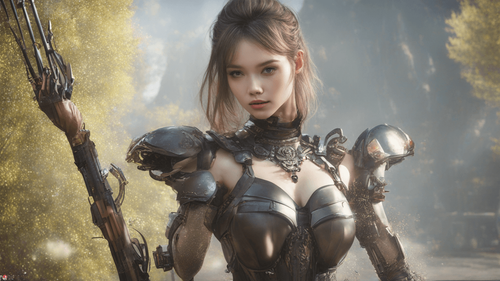
Introduction
In the rapidly evolving landscape of artificial intelligence, a groundbreaking innovation has taken center stage: an AI system that can create realistic images with unprecedented accuracy and creativity. This revolutionary technology, often referred to as "Generative Adversarial Networks" or GANs, has ignited excitement across various industries. From art and design to healthcare and entertainment, the potential applications of this AI system are virtually limitless.
Understanding AI System That Can Create Realistic Images
The Inner Workings of GANs
Generative Adversarial Networks (GANs) are a class of AI algorithms that consist of two neural networks: the generator and the discriminator. These networks work in tandem, with the generator creating images and the discriminator evaluating their realism. Through a continuous feedback loop, GANs progressively improve their ability to generate images that are indistinguishable from real ones.
Training on Big Data
The effectiveness of GANs lies in their ability to learn from vast datasets. By analyzing and understanding patterns within large volumes of data, the AI system refines its image generation process. This enables it to produce realistic images that encompass intricate details and nuances, making them virtually indistinguishable from those captured by cameras or handcrafted by artists.
Incorporating LSI Keywords
To enhance the realism and diversity of images, GANs utilize Latent Space Interpolation (LSI) techniques. LSI involves manipulating the latent space, a multidimensional vector space, to generate images that smoothly transition between different concepts. This capability allows the AI system to create a wide spectrum of images, from realistic to imaginative, catering to a range of artistic preferences and practical requirements.
The Artistic Applications of AI-Generated Images
Revolutionizing Visual Arts
The integration of AI-generated images into the world of visual arts has sparked a new wave of creativity. Artists and designers now collaborate with AI systems to explore uncharted territories, blurring the lines between human imagination and artificial intelligence. The AI system's ability to produce hyper-realistic images serves as a source of inspiration, pushing artists to explore unconventional mediums and styles.
AI-Infused Masterpieces
AI-generated images have not only found their place in modern art galleries but have also inspired the creation of awe-inspiring masterpieces. Through a harmonious fusion of human ingenuity and AI algorithms, renowned artists have harnessed the power of this system to bring their imaginative visions to life. The result is a collection of artworks that challenge conventions and redefine artistic boundaries.
Practical Applications Across Industries
Fashion and Design
The fashion and design industries have embraced the AI system's potential to create realistic images of garments, accessories, and interior spaces. Designers can visualize their concepts more effectively, enabling them to make informed decisions and refine their creations before embarking on the production process. This not only streamlines the design workflow but also reduces material waste and enhances customer satisfaction.
Healthcare Diagnostics and Training
In the realm of healthcare, AI-generated images have proven invaluable for diagnostic purposes and medical training. Radiologists can utilize these images to enhance their diagnostic accuracy, aiding in the identification of anomalies and irregularities. Medical students also benefit from lifelike simulations that provide hands-on training opportunities, ultimately contributing to improved patient care.
FAQs
How Does the AI System Learn to Generate Realistic Images?
The AI system learns to generate realistic images through a process of iterative training. The generator network creates images, while the discriminator network evaluates their authenticity. Through continuous feedback and adjustment, the AI system refines its image generation process, gradually improving its ability to create lifelike visuals.
Can the AI System Mimic Specific Artistic Styles?
Yes, the AI system can mimic specific artistic styles by analyzing existing artworks and learning the characteristics that define those styles. By incorporating this knowledge into its image generation process, the AI system can produce images that closely resemble the desired artistic style, offering a versatile tool for artists and designers.
What Sets LSI Techniques Apart in Image Generation?
Latent Space Interpolation (LSI) techniques set themselves apart by allowing smooth transitions between different concepts within the latent space. This means that the AI system can generate images that seamlessly blend different attributes or styles. LSI enhances the diversity and creative potential of the AI-generated images, making them adaptable to a wide range of applications.
Are AI-Generated Medical Images Reliable for Diagnostic Purposes?
AI-generated medical images have shown promising results for diagnostic purposes. However, they are often used as supplementary tools for enhancing the diagnostic process, rather than replacing traditional medical imaging techniques. Radiologists and healthcare professionals use AI-generated images alongside other diagnostic methods to ensure accurate and comprehensive assessments.
What Ethical Considerations Surround AI-Generated Art and Images?
The emergence of AI-generated art and images has sparked discussions around authorship, creativity, and the role of technology in artistic expression. Ethical considerations include giving credit to both the AI system and human collaborators, ensuring transparency about the involvement of AI, and preserving the unique value of human-generated art while embracing the opportunities AI presents.
What Does the Future Hold for AI Systems Creating Realistic Images?
The future of AI systems that create realistic images is both exciting and promising. As AI algorithms continue to advance, we can expect even more sophisticated and diverse image generation capabilities. From immersive virtual environments to personalized visual content, AI-generated images are poised to reshape industries and enrich human experiences.
Conclusion
In the realm of artificial intelligence, the advent of an AI system that can create realistic images marks a pivotal moment. This technology has transcended boundaries, redefining creativity, and offering innovative solutions across various domains. As we navigate this era of AI-powered image generation, the harmonious collaboration between human ingenuity and artificial intelligence holds the key to unlocking new dimensions of artistic expression, problem-solving, and exploration.